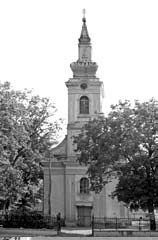The Sanctuary Church in Sanad was erected at the end of the 18th century as a single-storey building of Baroque architectural features. In the western grass, in function, the gallery is located. Four barrel-shaped grasses form the naos. The spacious altar apse comprises deep niches of prosthesis and deaconicon. The altar bulkheads and trunches are also wood-carved in the classical spirit.
In the Archives of Vojvodina in Sremski Karlovci there is a document from which it is learned that the Church Municipality in Sanad, in 1820, applied for permission to paint the iconostasis and enclosed the contract, made in three copies, which was made with the case of Aleksi Todorovic. On this basis it should be concluded that the iconostasis of the Serbian church in Sanad worked on this unknown author. However, the stylistic analogies, especially the colorist and drawing approach, refer to the painter Milutin Bedricic, a master of classicalism. The stylistic features of painting and woodworking work on the iconostasis allow dating in this period.
There are works that are uneven in quality on the iconostasis and thrones. On top icons, there is a brighter color, and no figure has any matching proportions.
The icon of the Virgin on the throne of the Virgin is a more pedantic work. The garments on the fabric were made with more tinting, and in the colorful and drawing treatment it has the most similarity with the work of Milutin Bedricic in the Serbian church in Jablanica.
In the attitudes of figure icons in the cloth, and the processing of fabrics still has the influence of Baroque painting. In the attitude and expression of Christ’s character, there is a similarity with Arseny Todorovic’s works.
Icons on the doors – Arhiđakon Stefan (above the northern doors), St. Dimitrija (above the southern doors), the Blessed Virgin, there is a discrepancy in proportions, more complex movements and positions. However, the scene “Victim Avram” is characterized by a more coherent composition. There are fifteen icons in the second zone. Central and lateral icons are wider, and among these there are six high and narrow picture fields. All of the compositions are shown, each divided into three planes. The first is the most commonly flat space, or two or three horizontal strips indicate a wide staircase leading to the central part of the painted surface (the other plan) in which the scene is. The third plan, the background, consists of parts of architecture or landscape, and those richer and diverse forms better fill the rest of the spaces.
Since the first plan is usually flat, the painter, in order to diminish the color and surface monotony, dropped some object on the floor. In the Assumption of the Virgin, there are swords and keys below, in Silasko Sv. a sword, again a sword, in the Birth of the Virgin, vessels and fabrics, in the Birth of Christ, a scepter and a crown (similar solutions have Dimitrije Popović on the iconostasis in Novi Kneževac).
Colors are predominantly green and blue. Red is less used. The painter gave more attention to narrative and episodic details than to coloring.
In the third zone there are icons with the standing figures of the Apostles, divided in two rows, and on the side there is one medallion with a figure of the prophets. In the middle is the Great Crucifixion, side by little distant, behind the cross are the medallions on which the Virgin and the John the Baptist are, and under the Crucifixion is the Crossing.
At the Arch of Throne, the scene of Christ is preached in the temple. Illustrations of many genre motifs are embedded in the religious scene. This theme was used by Arsenije Teodorovic for decorating and painting the Arch of Thrones (Baja, Novi Sad, Vrsac, Veliki Sent Miklos, Kucura, etc.).
In the church, there are still some other works which, due to the records on them or their artistic values, have paid attention when recording the monument in 1960. On the cross in the altar, on the Holy Table, it is said that it was donated in 1837. On the riffs are painted heads of angels, which are similar in shape to the works of Nikola Aleksic. In the office of the Church, there was an icon of the Virgin with Christ, which could be the work of a village iconographer, derived from the tradition of Baroque painting.
SERBIAN ORTHODOX CHURCH OF ST. ASSUMPTION OF THE LORD


0 comments on “SERBIAN ORTHODOX CHURCH OF ST. ASSUMPTION OF THE LORD”